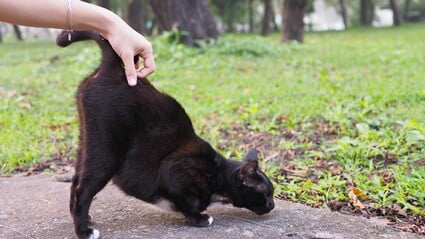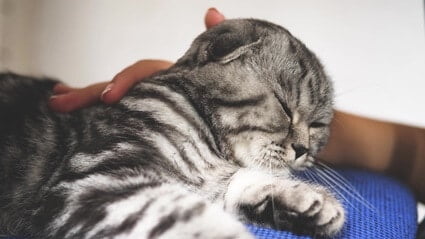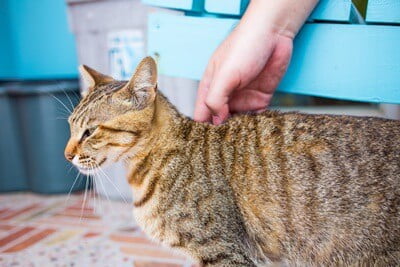Most cats enjoy being stroked on the back, except when they feel ill or are injured. So, if your cat doesn’t want to be touched on its back, the chances are that it’s experiencing physical discomfort.
Psychological or physical factors can cause back pain in cats. If the skin on a cat’s back ripples when touched, it may have anxiety or hyperesthesia (obsessive-compulsive disorder). If the cat’s back feels stiff to the touch, this may be due to arthritis, injury, or infection of the spinal discs.
Back pain due to anxiety or hyperesthesia can be resolved by reducing stress and changing how you stroke your cat. However, more serious conditions must be treated by a vet to avoid spinal damage.
How To Recognize Back Pain in Cats
Different medical conditions cause the following pain responses:
- Rippling – the skin on the cat’s back ripples and twitches involuntarily.
- Stiffness in the Back or Neck – the cat is unable to move quickly or stretch out fully.
- Flinching – the cat recoils when its back is touched.
What Causes Back Pain in Cats?
Various factors can cause a cat’s back to hurt, including:
- Soft tissue injuries – A strain or sprain to the muscles, ligaments, or tendons surrounding the backbones. A cat with a soft tissue injury may appear stiff and flinch when stroked.
- Fear and anxiety – If your cat always flinches when you touch it on the back, it may be anxious.
- Arthritis – This painful joint condition can affect the spine. Cats with arthritis may have a stiff neck and back that loosens after stroking.
- Hyperesthesia – This is a hypersensitivity disorder that causes a cat’s back to ripple.
- Feline osteodystrophy – Osteodystrophy is abnormal bone growth caused by genetics, renal disease, or nutrient deficiencies. Symptoms include stiffness and a reluctance to move.
- Discospondylitis – This is a microbial infection that affects the spinal discs, which can cause extreme stiffness.
- Meningitis – This causes inflammation or an infection of the meninges (the membranes that encase the brain and spinal cord). Meningitis can cause stiffness in the neck, and perhaps flinching, as cats with this condition won’t want to be touched.
Back pain has causes ranging from injury to infection and even psychological factors, such as anxiety.
Can Feline Back Pain Be Treated?
In most cases, back pain can be resolved successfully. Depending on the cause of the back pain, this may involve:
- Rest and rehabilitation – You may need to limit your cat’s movement by keeping it confined for several weeks.
- Changing your behavior – Depending on what’s causing the pain, changing how you handle and stroke your cat may lessen the symptoms.
- New environment – You may need to make some changes to your cat’s environment to speed up healing and prevent issues from happening in the future. For example, changing the temperature of your home, or getting a different cat bed.
- Medication – Anti-inflammatories, antibiotics, and pain relief meds.
Back Injuries in Cats
Soft tissue injuries are not uncommon in cats, though they are more likely to occur in the legs. A soft tissue injury can be a muscle strain, a torn ligament, or a sore tendon.
If your cat flinches or moves away when you try to touch its back, this might indicate a soft tissue injury. Other symptoms include:
- Struggling to get comfortable when sitting or lying down
- Swelling or warmth on the back or neck
- A reluctance to walk around or jump
- Spending lots of time alone
Back injuries in cats can be caused by falling off fences, worktops, or other high surfaces. Soft tissue injuries can be treated with prescribed pain relief and keeping your cat confined for 1-6 weeks.
Cat Scared When You Touch Its Back
Severe anxiety can be mistaken for physical pain. If your cat suddenly flinches when you touch its back, it might be in fear rather than pain.
If you catch your cat by surprise, this can be frightening. But how can you know if a cat is in pain or fear? Besides wide eyes, a frightened cat may:
- Puff up its tail
- Become frozen on the spot like a statue
- Arch its back
- Lower its head
- Have a glazed-over expression
- Spit and hiss
- Urinate or defecate outside the litter box
- Try to run away
Cats can develop anxiety for many reasons. Perhaps they have had a traumatic past or don’t feel safe in their current home. If left alone, severe anxiety can lead to hyperesthesia.
Feline Hyperesthesia
If your cat’s fur ripples when you touch it on the back, it may have hyperesthesia. This is a hypersensitivity disorder that can cause the skin on the back to twitch and ripple uncontrollably.
It is the muscle underneath the skin that is being overstimulated. The ripples may be triggered by stroking, grooming, stressful situations, or temperature changes.
In addition to twitching skin, cats will usually experience additional symptoms such as:
- Running around
- Frantic grooming
- Salivation
- Uncontrollable urination
- Excessive meowing
- Flinching
Specialists at Cornell University consider it to be a form of epilepsy. However, they also believe that anxiety and obsessive-compulsiveness may play a role in this condition. Episodes tend to last a couple of minutes, but they can frequently occur throughout the day.
Can I Stroke a Cat with Hyperesthesia?
If your cat is showing the signs of hyperesthesia, you might wonder if it’s safe to stroke it or kinder to leave it alone. Some cats with anxiety/hyperesthesia will appreciate human contact, but you should take steps not to aggravate the condition:
- Stroke your cat elsewhere on the body, as this might be less triggering. For example, your cat might enjoy rubbing its face against your hand as this allows it to mark territory. Try hovering your hand near to your cat and let it rub up to you in any way it chooses. That way, you’ll get a sense of where it likes to be stroked.
- Be gentle with your strokes. Cats are only small, so you don’t need to apply the same amount of pressure you would if you were hugging a person. Try soft, gentle strokes using only your fingers or just a small section of your hand.
- Sit down with your cat for several minutes before you go to stroke it. This will stop it from becoming startled.
- If your cat has an episode of anxiety/hyperesthesia and starts frantically scratching its back, don’t try to intervene at this point – allow this flare-up to run its course.
However, it would help if you treated hyperesthesia as it can lead to skin wounds, weight loss, and a poor quality of life. Hyperesthesia can be successfully treated through behavioral change rather than medication.

How to Handle An Anxious Cat
If the skin on your cat’s back ripples uncontrollably, it likely has anxiety and hyperesthesia. Cats get anxious if they are living in an unsuitable environment or they have to fight for resources. To treat anxiety and hyperesthesia, consider the following interventions:
Own Space
If you have more than one cat, ensure that each cat has its own food bowl, water bowl, litter box, and sleeping spot/bed.
Increased Interaction
If a cat feels bored or under-stimulated, this can lead to anxiety. As a minimum, give your cat attention for 3 x 10 minutes each day.
If your cat doesn’t like being stroked on the back, you can stroke it elsewhere on the body or offer some toys to play with instead. Toys needn’t be expensive as cats enjoy playing with balls of wool, old cardboard tubes, and boxes.
Small, Regular Meals
If practical, feed your cat 4-6 small meals per day rather than 1-2 big ones. Also, stick to the same feeding routine each day so that your cat doesn’t have to worry about getting its next meal.
You could also get a specialist feeding bowl that forces the cat to search for its food. This prevents boredom and encourages an anxious cat to eat at a steadier pace.
Keep Rival Cats Away
If you have an indoor cat, it might feel threatened by animals it sees through the window. Use curtains to block any windows that look over the yard and stop other cats from entering your home.
Pheromone Device
Get a pheromone plug-in device. These plug-in devices release an artificial substance that mimics the cat’s pheromones. When cats scent-mark (by rubbing their cheeks against household surfaces), they release pheromones.
The idea is that these artificial pheromones help a cat feel more secure in its environment. If you don’t want to get a plug-in device, you could gently wipe a clean cloth against your cat’s cheeks and then rub it on surfaces around your home to deposit the scent.
Spinal Arthritis in Cats
Arthritis is a condition that affects the joints, and it is common in senior cats. Arthritic cats often feel stiff and sluggish when you stroke them, but the stiffness eases up after a couple of minutes. According to Cats Protection, additional symptoms include:
- An inability to move around with ease, or a reluctance to jump
- Unable to use the litter box
- Moody
- Swelling around the joints
- A stiffness that loosens up after some physical activity
- Symptoms that worsen in damp or cold weather
If your cat has arthritis, the symptoms can be alleviated with prescription anti-inflammatory drugs. Glucosamine or chondroitin sulfate are also thought to alleviate the symptoms of arthritis and repair damaged cartilage.
What is Feline Osteodystrophy?
This condition is rare but worth mentioning because it can cause severe and irreversible damage to the spinal cord if not treated early.
Feline osteodystrophy is an abnormal growth of the bones. It can cause intense pain, deformity, stiffness, and a reluctance to jump/walk. According to Wiley, the risk factors for developing feline osteodystrophy are:
- Genetics – Siamese, Burmese, and Scottish fold cats are more likely to have this condition.
- Diet – A diet low in calcium, iron, and vitamin D is a risk factor, particularly in kittens. Siamese cats are picky about their food, which may partially explain the high numbers of osteodystrophy in Siamese cats. Cats who are fed only scraps may also suffer these deficiencies.
Treatment involves dietary changes (increased calcium, iron, and vitamin D intake) and confinement for several weeks. Scottish fold cats with this condition will often need surgery.

Discospondylitis
This is caused by a microbial infection that enters the cat’s spinal discs. It could be due to a bacterial or fungal infection from another animal or needles not being appropriately cleaned during inoculation. In addition to back pain, cats with discospondylitis may have:
- Fever
- Loss of appetite and weight loss
- Lethargy
- Paralysis
According to Science Direct, treatment involves an antimicrobial treatment, followed by pain relief. Also, cats usually need to be confined for several weeks to promote healing and prevent reinfection.
Feline Meningitis
Cats that feel unusually stiff around the neck area may have meningitis. If your cat finds it hard to twist its neck, this could be a red flag. Meningitis is an inflammation or infection of the meninges – the membranes encase the cat’s central nervous system. Additional symptoms include:
- Fever
- Vomiting
- Depression and low mood
- Low blood pressure
- Oversensitivity to light
- Weight loss and loss of appetite
- Unsteadiness
Meningitis can lead to brain damage and other secondary infections if left untreated. A dose of antibiotics, rest, and relaxation can be effective if the infection is caught sufficiently early. If you suspect your cat is in pain, you need to establish what it looks like. Is your cat flinching? Is its skin rippling, or does its back feel particularly stiff?
Skin rippling is often associated with psychological factors (i.e., anxiety, hyperesthesia), whereas stiffness is more commonly associated with injury and infection. Flinching (moving back) when touched can be a symptom of both psychological and physical conditions.
If you suspect your cat has hyperesthesia or anxiety, you may be able to manage this condition. Be more gentle when stroking your cat and allow it to take the lead. Moreover, minimize all sources of stress in the household and use a pheromone plug-in to make your cat feel more secure.

